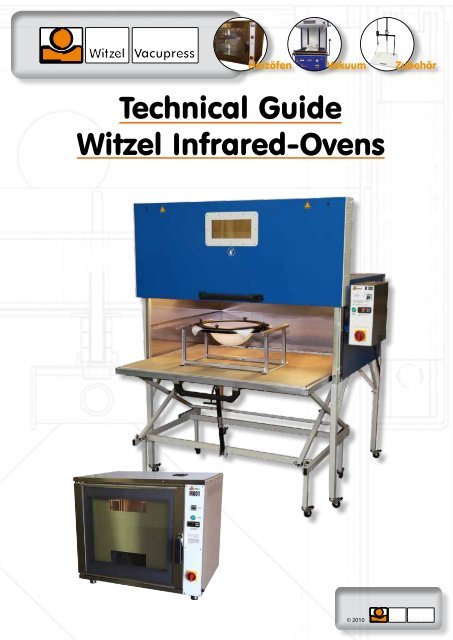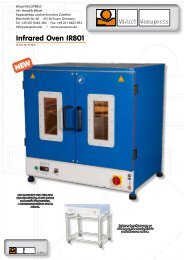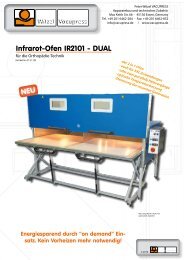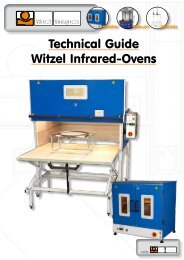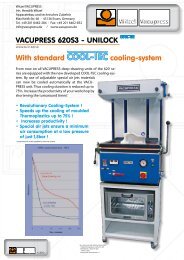Special features of the Witzel Infrared-Oven line - vacupress.de
Special features of the Witzel Infrared-Oven line - vacupress.de
Special features of the Witzel Infrared-Oven line - vacupress.de
Create successful ePaper yourself
Turn your PDF publications into a flip-book with our unique Google optimized e-Paper software.
Technical Gui<strong>de</strong><br />
Heizöfen Vakuum Zubehör<br />
<strong>Witzel</strong> <strong>Infrared</strong>-<strong>Oven</strong>s<br />
© 2010
Heizöfen Vakuum Zubehör<br />
Introduction<br />
This technical gui<strong>de</strong> is addressed to <strong>the</strong> users and <strong>de</strong>cision makers <strong>of</strong> O&P and o<strong>the</strong>r<br />
orthopaedic workshops. It does provi<strong>de</strong> an overview on <strong>the</strong> basics <strong>of</strong> <strong>Infrared</strong>-<strong>Oven</strong><br />
technology, <strong>the</strong> differences comparing to traditional convection ovens and <strong>the</strong> specific<br />
benefits and advantages <strong>of</strong> <strong>the</strong> <strong>Witzel</strong> <strong>Infrared</strong>-oven <strong>line</strong>.<br />
At this point we would like to give thanks to all our customers for <strong>the</strong> constructive<br />
dialog and <strong>the</strong> numerous feedback. We are always running a large number <strong>of</strong> our<br />
own intensive tests to permanently improve our products. But we are also reliant on<br />
<strong>the</strong> tips and experiences coming from you - from <strong>the</strong> practice.<br />
From experience - into practice<br />
Your <strong>Witzel</strong> VACUPRESS Team<br />
Content<br />
• <strong>Infrared</strong>-<strong>Oven</strong> basics<br />
• Basic distinctions comparing with Convection-<strong>Oven</strong>s<br />
• <strong>Special</strong> <strong>features</strong> <strong>of</strong> <strong>the</strong> <strong>Witzel</strong> <strong>Infrared</strong>-<strong>Oven</strong> <strong>line</strong><br />
• FAQ – Frequently asked questions<br />
© 2010
<strong>Infrared</strong>-<strong>Oven</strong> basics<br />
Heizöfen Vakuum Zubehör<br />
During <strong>the</strong> last years <strong>Infrared</strong>-<strong>Oven</strong>s gained a growing importance in <strong>the</strong> O&P field and its workshops.<br />
<strong>Infrared</strong> heating is replacing <strong>the</strong> traditional convection style ovens or heating plates.<br />
The reason is not far to seek. <strong>Infrared</strong>-<strong>Oven</strong>s combine a whole array <strong>of</strong> benefits in just one unit. <strong>Infrared</strong>-heat<br />
is radiant heat which acts directly. Different to convection style ovens where air is heated<br />
up to heat indirectly, <strong>Infrared</strong>-heat is applied directly to <strong>the</strong> material - without any indirection and<br />
thus much faster and more energy-efficient.<br />
Due to this direct mo<strong>de</strong> <strong>of</strong> operation <strong>the</strong>re is no need for any preheating <strong>of</strong> <strong>Infrared</strong>-<strong>Oven</strong>s. The result<br />
is a distinctive reduction <strong>of</strong> <strong>the</strong> energy consumption. Ano<strong>the</strong>r benefit <strong>of</strong> this technology is <strong>the</strong><br />
tremendous speed it heats <strong>the</strong> <strong>the</strong>rmoplastics. Just 10 - 12 minutes processing time (started from<br />
<strong>the</strong> cold oven) for a 10 mm test socket material (e.g. PET) in a blister forming tray or a 1 x 1 meter<br />
sized Polyethylene <strong>of</strong> 4 - 5 mm thickness speak for itself. During continuous running <strong>the</strong>se values<br />
are fur<strong>the</strong>r un<strong>de</strong>rcut. Fur<strong>the</strong>r <strong>the</strong> way <strong>the</strong> infrared rays enter <strong>the</strong> material have a positive effect on<br />
its characteristics. The practical experience approves that <strong>the</strong>rmoplastics material which have been<br />
heated in an <strong>Infrared</strong>-<strong>Oven</strong> mould smoo<strong>the</strong>r and pull better than materials which have been heated<br />
in a traditional way.<br />
© 2010
Heizöfen Vakuum Zubehör<br />
Basic distinctions <strong>of</strong> <strong>Infrared</strong>-<strong>Oven</strong>s comparing with<br />
Convection-<strong>Oven</strong>s and Heating plates<br />
Convection ovens and Heating plates heat <strong>the</strong>rmoplastic materials indirectly by use <strong>of</strong> electrical<br />
heating resistors which heat circulated air, resp. a metal contact plate. These in turn heat <strong>the</strong> material<br />
itself. Ei<strong>the</strong>r <strong>the</strong> circulated air in a convection oven as well as <strong>the</strong> metal contact plates <strong>of</strong> a heating<br />
plate need preheating times <strong>of</strong> up to one hour. In practice this means that <strong>the</strong>se units are running<br />
<strong>the</strong> whole work day <strong>of</strong> 8 hours or more.<br />
<strong>Infrared</strong>-<strong>Oven</strong>s however work with direct radiant heat The electrical heating coils generate <strong>Infrared</strong><br />
rays which heat <strong>the</strong> material surface directly and without any indirection. By <strong>the</strong> enormous shortening<br />
<strong>of</strong> <strong>the</strong> heating processes, <strong>Infrared</strong>-<strong>Oven</strong>s increase <strong>the</strong> efficiency <strong>of</strong> <strong>the</strong> workshop and <strong>of</strong>fer a<br />
significant energy saving potential by lapse <strong>of</strong> any preheating and idle running times..<br />
Unit Power consumption<br />
/kW<br />
© 2010<br />
actual / idle running time<br />
<strong>of</strong> <strong>the</strong> heating elements / h<br />
IR1301 <strong>Infrared</strong>-<strong>Oven</strong> 8,3 4h (3 x 10 min. x 9h) 33,2<br />
Traditional Convection <strong>Oven</strong> 6,8 9h (incl. Preheating,<br />
<strong>Oven</strong> runs whole day<br />
Consumption<br />
kW / day<br />
61,2<br />
Average potential in energy savings for <strong>Infrared</strong>-<strong>Oven</strong>s:<br />
-energy savings per day = 28 kWh<br />
-energy savings per year (240 work days / year) = 6720 kWh<br />
-Reduction <strong>of</strong> energy costs per year (1 kWh = 0,18 €) = 1209,60 €<br />
Tech-Tip:<br />
All <strong>Witzel</strong> <strong>Infrared</strong>-<strong>Oven</strong>s shut down <strong>the</strong> <strong>Infrared</strong>-tubes automatically when <strong>the</strong><br />
oven door is opened. This saves even more energy and prolongs <strong>the</strong> life time <strong>of</strong> your<br />
oven.
<strong>Special</strong> <strong>features</strong> <strong>of</strong> <strong>the</strong> <strong>Witzel</strong> <strong>Infrared</strong>-<strong>Oven</strong> <strong>line</strong><br />
Heizöfen Vakuum Zubehör<br />
The fact that <strong>Infrared</strong>-<strong>Oven</strong>s heat <strong>the</strong> material directly, but not <strong>the</strong> air around in <strong>the</strong> oven is a particular<br />
challenge for <strong>the</strong> technology <strong>of</strong> such a system. The air insi<strong>de</strong> <strong>the</strong> oven <strong>of</strong> course heats up as well,<br />
but always just indirectly, caused by <strong>the</strong> hot si<strong>de</strong> walls or <strong>the</strong> hot material. Thus <strong>the</strong> air temperature<br />
insi<strong>de</strong> <strong>the</strong> oven is always different to <strong>the</strong> material temperature and thus a traditional temperature<br />
sensor like it is used in convection ovens cannot act exactly in such a unit.<br />
Different to o<strong>the</strong>rs, all <strong>Witzel</strong> <strong>Infrared</strong>-<strong>Oven</strong>s are equipped with an elaborated technology which<br />
allows to measure <strong>the</strong> exact surface temperature <strong>of</strong> <strong>the</strong> material. An optical sensor records <strong>the</strong> surface<br />
temperature <strong>of</strong> <strong>the</strong> material to be heated. In combination with a microprocessor operated PID<br />
Controller <strong>the</strong> user has <strong>the</strong> perfect control on <strong>the</strong> heating process. Thus overheated materials and<br />
burned plastics belong to <strong>the</strong> past.<br />
Elaborate test runs and our own experiences in <strong>the</strong> O&P field have led to a system which combines<br />
<strong>the</strong> enormous power <strong>of</strong> infrared-heat with an optimized Thermostat-control. This system unifies a<br />
maximum <strong>of</strong> heating power with perfect control <strong>of</strong> <strong>the</strong> processing. <strong>Witzel</strong> <strong>Infrared</strong>-<strong>Oven</strong> are build for<br />
multi-purpose use. Flat plastics can be heated as well as Blister forming trays for pros<strong>the</strong>tic sockets.<br />
When <strong>de</strong>veloping <strong>the</strong> <strong>Witzel</strong> <strong>Infrared</strong>-<strong>Oven</strong>s we took special care <strong>of</strong> an even heating result at <strong>the</strong><br />
entire heating area. Who doesn’t know <strong>the</strong> experience <strong>of</strong> uneven heating results in his convection<br />
oven or <strong>the</strong> cold edges <strong>of</strong> <strong>the</strong> old heating plate. During extensive test runs on all <strong>Witzel</strong> <strong>Infrared</strong>-<strong>Oven</strong>s<br />
we have been able to optimize <strong>the</strong> spreading <strong>of</strong> <strong>the</strong> <strong>Infrared</strong>-tubes to that effect. Custom ma<strong>de</strong><br />
<strong>Infrared</strong>-tubes, manufactured for <strong>the</strong> special needs <strong>of</strong> our <strong>Oven</strong>s guarantee an even heating all over<br />
<strong>the</strong> effective heating area. <strong>Infrared</strong>-tubes with different capacities ensure an optimized heating <strong>of</strong><br />
<strong>the</strong> edges too.<br />
Fur<strong>the</strong>r <strong>the</strong> latest generation <strong>of</strong> <strong>Witzel</strong> <strong>Infrared</strong>-<br />
<strong>Oven</strong>s is equipped with a PID-Controller with<br />
two-<strong>line</strong> display which also allows to store four<br />
individual temperature pre-settings which can be<br />
easily called up by a speed-dial button<br />
© 2010
Heizöfen Vakuum Zubehör<br />
FAQ - Frequently asked questions<br />
Which kind <strong>of</strong> materials can be heated with <strong>Witzel</strong> <strong>Infrared</strong>-<strong>Oven</strong>s?<br />
Generally every <strong>the</strong>rmoplastic material available in <strong>the</strong> O&P field can be processed. During <strong>the</strong><br />
<strong>de</strong>velopment <strong>of</strong> <strong>the</strong> <strong>Witzel</strong> <strong>Infrared</strong>-<strong>Oven</strong>s we took special care that <strong>the</strong> optical sensor does work<br />
with clear plastics as well as with colored ones.<br />
Caused by <strong>the</strong> <strong>Infrared</strong>-rays which enter <strong>the</strong> material, <strong>the</strong> materials which were heated in an<br />
<strong>Infrared</strong>-<strong>Oven</strong> mould better than <strong>the</strong> ones heated traditionally. Fur<strong>the</strong>r <strong>the</strong> colors <strong>of</strong> applied<br />
Thermotransfer-papers are more clear and bright.<br />
Do I need a special Blister forming tray to process pros<strong>the</strong>tic sockets with<br />
my <strong>Witzel</strong> <strong>Infrared</strong>-<strong>Oven</strong>?<br />
No, you can go on using your existing Blister forming tray without any limitation. It is just important<br />
to observe <strong>the</strong> correct distance between material and <strong>Infrared</strong>-tubes. For your guidance all<br />
<strong>Witzel</strong> <strong>Infrared</strong>-<strong>Oven</strong>s have a circumference edge insi<strong>de</strong> <strong>the</strong> housing. If applicable just adjust <strong>the</strong><br />
legs <strong>of</strong> your tray or <strong>the</strong> height <strong>of</strong> <strong>the</strong> cradle to <strong>the</strong> height <strong>of</strong> this circumference edge. Thus you<br />
ensure an even heating result.<br />
Wouldn`t it still be helpful to preheat my <strong>Witzel</strong> <strong>Infrared</strong>-<strong>Oven</strong>?<br />
No! <strong>Infrared</strong>-heat doesn`t heat air, but just objects. The air insi<strong>de</strong> <strong>the</strong> oven is just heated up indirectly<br />
by <strong>the</strong> hot si<strong>de</strong>walls or <strong>the</strong> hot tray and material. Thus our <strong>Witzel</strong> <strong>Infrared</strong>-<strong>Oven</strong>s don`t measure<br />
<strong>the</strong> air temperature insi<strong>de</strong> <strong>the</strong> oven but surface temperature <strong>of</strong> <strong>the</strong> material to be heated itself.<br />
Preheating <strong>the</strong> empty oven gives an advantage non-gaugeable. But it is a waste <strong>of</strong> expensive<br />
energy and shortens <strong>the</strong> lifetime <strong>of</strong> <strong>the</strong> <strong>Infrared</strong>-tubes. This is exactly <strong>the</strong> reason why all <strong>Witzel</strong><br />
<strong>Infrared</strong>-<strong>Oven</strong>s shut down <strong>the</strong> <strong>Infrared</strong>-tubes automatically when <strong>the</strong> door is opened.<br />
Is <strong>the</strong>re a blower fan available for <strong>Witzel</strong> <strong>Infrared</strong> <strong>Oven</strong>s?<br />
No! As mentioned <strong>Infrared</strong>-heat heats just materials and not air. Thus <strong>the</strong> air insi<strong>de</strong> <strong>the</strong> oven is always<br />
cooler than <strong>the</strong> material. Thus a blower fan in an <strong>Infrared</strong>-<strong>Oven</strong> is a kind <strong>of</strong> a cooling blower<br />
and has a more negative than positive effect on <strong>the</strong> heating process.<br />
My materials are shrinking a lot when heating up. What can I do to prevent it?<br />
Generally every plastic has some shrinking caused by its “memory”. Depending on <strong>the</strong> manufacturing<br />
method this unwanted character is more or less distinctive. At <strong>the</strong> O&P field <strong>the</strong>re are several<br />
materials available which are additionally marked “non shrinking”. On <strong>the</strong> o<strong>the</strong>r hand <strong>the</strong>re<br />
are <strong>of</strong>ten budget-friendly PP or PE materials available which are not sufficient for <strong>the</strong> O&P field<br />
because <strong>of</strong> <strong>the</strong>ir enormous shrinking. These materials cannot be processed in any “open” oven like<br />
<strong>Infrared</strong> or Convection <strong>Oven</strong>s are. Just “closed” systems like heating plates are able to provi<strong>de</strong> <strong>the</strong><br />
nee<strong>de</strong>d pressure to hold <strong>the</strong> material and prevent it from <strong>the</strong> shrinking during heating up.<br />
© 2010
Heizöfen Vakuum Zubehör<br />
Why does my material not heat evenly?<br />
The most common fault when using <strong>Infrared</strong>-<strong>Oven</strong>s is a wrong distance between material and<br />
<strong>Infrared</strong>-tubes. As mentioned <strong>Infrared</strong>-heat is radiant-heat. During <strong>de</strong>velopment we took special<br />
care on <strong>the</strong> even heating <strong>of</strong> our <strong>Infrared</strong>-<strong>Oven</strong>s - up to <strong>the</strong> edges. A special spreading <strong>of</strong> <strong>the</strong><br />
<strong>Infrared</strong>-tubes and different capacities <strong>of</strong> <strong>the</strong> tubes ensure an optimal functionality. To get best<br />
results it is unconditionally necessary to place <strong>the</strong> material at <strong>the</strong> right distance to <strong>the</strong> <strong>Infrared</strong>tubes.<br />
For your guidance all <strong>Witzel</strong> <strong>Infrared</strong>-<strong>Oven</strong>s have a circumference edge insi<strong>de</strong> <strong>the</strong> housing.<br />
From IR1001 on all <strong>Witzel</strong> <strong>Infrared</strong>-<strong>Oven</strong>s are equipped with a height adjustable Roll-About-Tray.<br />
Note for Blister forming trays: If applicable adjust <strong>the</strong> legs <strong>of</strong> your tray or <strong>the</strong> height <strong>of</strong> <strong>the</strong> cradle<br />
to <strong>the</strong> height <strong>of</strong> this circumference edge. Thus you ensure an even heating result.<br />
What is <strong>the</strong> difference between “even” and “porous” Teflon coatings?<br />
<strong>Witzel</strong> <strong>Infrared</strong>-<strong>Oven</strong>s are equipped with replaceable porous Teflon-coatings as standard. Porous<br />
means that <strong>the</strong> Teflon-coating is air-permeable. This <strong>of</strong>fers <strong>the</strong> advantage that air which is un<strong>de</strong>rneath<br />
<strong>the</strong> flat plastics during <strong>the</strong> heating process can escape. Thus you don`t have <strong>the</strong> unwanted<br />
“maps” at <strong>the</strong> un<strong>de</strong>rsi<strong>de</strong> <strong>of</strong> <strong>the</strong> heated material. Ano<strong>the</strong>r benefit <strong>of</strong> <strong>the</strong> porous Teflon comparing<br />
to <strong>the</strong> even one is that it has less adhesion when lifting <strong>the</strong> heated material. Especially s<strong>of</strong>t materials<br />
can be lifted much easier and don`t get stretched that much.<br />
When heating 2 mm PP sheets <strong>the</strong> edges roll up. What can I do to prevent this?<br />
Interestingly this phenomenon does not show up with every 2 mm PP. It looks like it <strong>de</strong>pends <strong>of</strong><br />
<strong>the</strong> manufacturer <strong>of</strong> <strong>the</strong> plastic. Also <strong>the</strong> direction <strong>of</strong> rolling can have an effect on it. Should this<br />
problem arise you can easily prevent it by putting a piece <strong>of</strong> Teflon coating on top <strong>of</strong> <strong>the</strong> 2 mm<br />
PP when placing it at <strong>the</strong> oven tray (The Teflon should be a little larger than <strong>the</strong> material). The<br />
<strong>Infrared</strong>-heat passes <strong>the</strong> Teflon without any problems and already <strong>the</strong> low weight <strong>of</strong> <strong>the</strong> Teflon<br />
prevents <strong>the</strong> roll up <strong>of</strong> <strong>the</strong> edges. If necessary you can raise <strong>the</strong> temperature by one or two <strong>de</strong>gree<br />
and prolong <strong>the</strong> heating time a little bit if <strong>the</strong> Teflon should reduce <strong>the</strong> heat a little bit.<br />
We work with our <strong>Infrared</strong>-<strong>Oven</strong> for some time. Since a few days our material is burned, resp. we<br />
feel that it overheats, even if <strong>the</strong> correct temperature is set and displayed and worked fine in <strong>the</strong><br />
past.<br />
<strong>Witzel</strong> <strong>Infrared</strong>-<strong>Oven</strong>s are all equipped with an optical temperature sensor which measures <strong>the</strong><br />
surface temperature <strong>of</strong> <strong>the</strong> material. This optical sensor is located in <strong>the</strong> center <strong>of</strong> <strong>the</strong> top <strong>of</strong> <strong>the</strong><br />
oven, next to <strong>the</strong> <strong>Infrared</strong>-tubes and “looks” onto <strong>the</strong> material from <strong>the</strong> top. Dust and o<strong>the</strong>r influences<br />
can pollute <strong>the</strong> optic and <strong>the</strong>n <strong>the</strong> controller does not work properly any longer. This leads<br />
to an overheating even if <strong>the</strong> temperature is set correctly. The optical sensor should be cleaned<br />
according to <strong>the</strong> manual instruction. Depending on <strong>the</strong> settings it should be controlled every<br />
three month and cleaned up if necessary.<br />
© 2010
Heizöfen Vakuum Zubehör<br />
For more <strong>de</strong>tails <strong>of</strong> all products visit<br />
http://www.<strong>vacupress</strong>.<strong>de</strong>/en/Products/Catalog_2010<br />
© 2010<br />
IR1001 <strong>Infrared</strong>-<strong>Oven</strong><br />
Main purpose:<br />
Orthotics , Pros<strong>the</strong>tics<br />
Heated area dimensions (Teflon):<br />
92 x 72 cm, Roll-About Tray, moveable and height<br />
adjustable for Blister-Forming Trays<br />
Heating:<br />
10 <strong>Infrared</strong>-Tubes with single reflector<br />
Electrical Connection:<br />
400V, 50-60 Hz, 7,7 kW (16A CEE)<br />
IR1301 <strong>Infrared</strong>-<strong>Oven</strong><br />
Main purpose:<br />
Orthotics , Pros<strong>the</strong>tics<br />
Heated area dimensions (Teflon):<br />
124 x 104 cm, Roll-About Tray, moveable and height<br />
adjustable for Blister-Forming Trays<br />
Heating:<br />
18 <strong>Infrared</strong>-Tubes with single reflector<br />
adjustable in 2 zones (6 / 18)<br />
Electrical Connection:<br />
400V, 50-60 Hz, 8,3 kW (16A CEE)<br />
IR601 <strong>Infrared</strong>-<strong>Oven</strong><br />
Main purpose:<br />
Pros<strong>the</strong>tics, Orthotics, flat plastics up to 50x30 cm<br />
Heated area dimensions (Teflon):<br />
-Tray 60x40 cm<br />
-for Blister forming trays 45x45 cm<br />
Heating:<br />
4 + 2 <strong>Infrared</strong>-Tubes with single reflector<br />
Electrical Connection:<br />
230V, 50-60 Hz, 3,5 kW (16A SCHUKO)<br />
IR2101 DUAL <strong>Infrared</strong>-<strong>Oven</strong><br />
Main purpose:<br />
Orthotics , Pros<strong>the</strong>tics<br />
Heated area dimensions (Teflon):<br />
214 x 104 cm, or usable as 2x 107 x 104 cm<br />
Roll-About Tray, moveable and height adjustable for<br />
Blister-Forming Trays<br />
Heating:<br />
28 <strong>Infrared</strong>-Tubes with single reflector<br />
can be controlled separately as 2 <strong>Oven</strong>s with 14<br />
IR-Tubes each<br />
Electrical Connection:<br />
400V, 50-60 Hz, 12,9 kW (32A CEE)<br />
Peter <strong>Witzel</strong> Vacupress Apparatebau<br />
Max Keith Str. 66 - D-45136 Essen<br />
Tel. +49 201 6462-284 - Fax: +49 201 6462-852<br />
info@<strong>vacupress</strong>.<strong>de</strong> / www.<strong>vacupress</strong>.<strong>de</strong>


